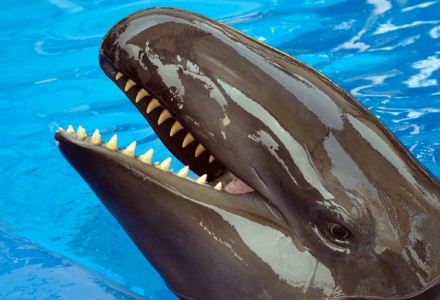
False Killer Whale Facts
- Despite the common name, the False Killer Whale is a member of the Blackfish group. Thus, the remarkable animal isn’t a whale at all. This impressive ocean species actually represents one of the largest members of the dolphin family.
- This species also exhibits the same spirit of playfulness that the smaller and better-known dolphin species do. As a result of this behavior, it remains the only member of its group to ride bow waves on a regular basis.
- However, due to its depredation of fishing lines, it continues to be routinely hunted in parts of its endemic range. Additionally, this predominantly occurs in Japan, where it, unfortunately, remains the target of organized hunting drives.
- Due to such activities, in addition to other dangers, it now faces grave concerns for its future. While the IUCN does include it on the Red List of Threatened Species, its current status remains Data Deficient.
Related Articles
Beluga Whale Narwhal Hourglass Dolphin
Photographer: Juan Ortega
CC License: https://bit.ly/3iz4TQk
False Killer Whale Physical Description
Firstly, the False Killer Whale, like many related species displays a certain degree of sexual dimorphism. However, in the case of this species, the visible physical difference remains very slight.
Due to this fact, individuals of both genders of this particular species attain roughly the same size. Therefore, each gender typically attains an average body length of about 16.1 ft (4.9 m).
However, exceptional male individuals do tend to attain a greater length and weight. As a result of this tendency, these males sometimes reach a maximum measured weight of 4,900 lb (2,200 kg).
On the other hand, exceptional female individuals may attain a maximum known weight of about 2,600 lb (1,200 kg).
In addition, the coloring typically consists of a pattern of dark gray or black on the upper side and a slightly lighter coloring underneath.
- Kingdom: Animalia
- Phylum: Chordata
- Class: Mammalia
- Order: Artiodactyla
- Family: Delphinidae
- Genus: Pseudorca
- Species: P. crassidens
Photographer: Juan Ortega
CC License: https://bit.ly/3AqKoex
False Killer Whale Distribution, Habitat, and Ecology
Most notably, the magnificent False Killer Whale has a quite broad, yet specific distribution. While it inhabits three separate oceans, it primarily occurs only in the temperate or tropical regions.
The vast majority of individuals tend to appear on the surface. However, it typically inhabits regions with a depth greater than 3,300 ft (1,000 m). Why it does this continues to remain a mystery to researchers.
Further, like all dolphins, it evolved as a pure carnivore and primarily feeds on fish and cephalopods. Yet small marine mammals will occasionally be taken as well. This usually occurs due to a lack of larger prey.
Additionally, it has a highly social nature and typically inhabits pods of between 10-60 individuals. It also often temporarily joins with pods of other dolphin species, sometimes forming groups of hundreds.
This species reaches maturity at about 12 years of age and has an average lifespan of about 60 years. Sadly, for reasons that remain a mystery, it also ranks among the most common cetaceans to engage in mass strandings.
Species Sharing Its Range
Spanish Shawl Blue Shark Vaquita
Check out our other articles on Minke Whale, Pantropical Spotted Dolphin, Risso’s Dolphin, 9 Truly Magnificent Mantises, Colorado Columbine, Tawny Frogmouth, Thorny Dragon

